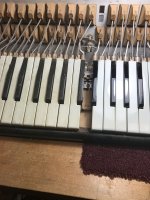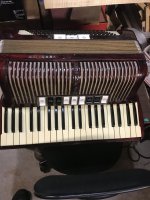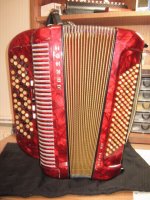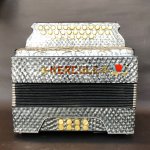32251
Active member
I have been working with celluloid used in binding guitars for decades. I miss seeing it used anymore on guitars.
Now on vintage accordions I am enjoying seeing it used covering the entire instrument. Even though the outer celluloid layer is usually very thin, you still have enough to rejuvenate the surface and make the instrument look very nice again.
First I inspect the covering and see what will be the best approach. Light surface scratching you can just use rubbing compounds in different grades by hand with cotton cloths. Be careful if you use buffing wheels because of potential heat damage if you aren’t careful.
Bad scratches,oxidation etc. sand first. I start with 220/240 in the worst spots and then 320 to 400 to 600 then rubbing compounds. It’s amazing how much you can improve the surface doing this. Here is a keyboard I’m working on. Look at the difference between the oxidized left side and the polished right side.
Another thing I find interesting is in guitar repair, I see what we call “binding rot” where the celluloid just gasses out to goo and then falls apart. I wonder why I don’t see this more in accordions. I see some key surfaces cracking, but I don’t see catastrophic celluloid body covering issues.
Now on vintage accordions I am enjoying seeing it used covering the entire instrument. Even though the outer celluloid layer is usually very thin, you still have enough to rejuvenate the surface and make the instrument look very nice again.
First I inspect the covering and see what will be the best approach. Light surface scratching you can just use rubbing compounds in different grades by hand with cotton cloths. Be careful if you use buffing wheels because of potential heat damage if you aren’t careful.
Bad scratches,oxidation etc. sand first. I start with 220/240 in the worst spots and then 320 to 400 to 600 then rubbing compounds. It’s amazing how much you can improve the surface doing this. Here is a keyboard I’m working on. Look at the difference between the oxidized left side and the polished right side.
Another thing I find interesting is in guitar repair, I see what we call “binding rot” where the celluloid just gasses out to goo and then falls apart. I wonder why I don’t see this more in accordions. I see some key surfaces cracking, but I don’t see catastrophic celluloid body covering issues.




